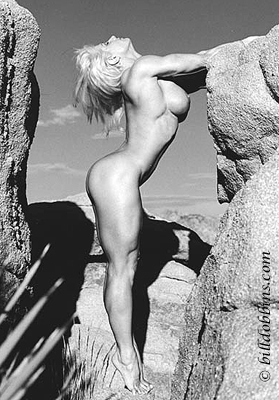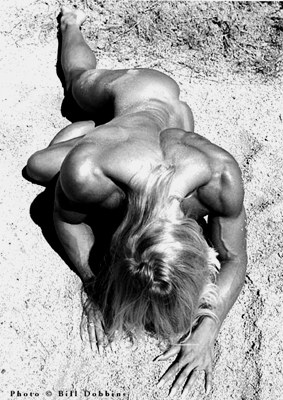PHOTOGRAPHING THE NUDE
by Bill Dobbins
THE LEGACY OF GREECE
T he ancient
Greeks were among the first to treat the human body as an art form. They glorified
the male athletic body. The idea of the professional athlete, whose achievements
on the playing field were appreciated for their own sake, was born in Greece.
Men competed in the early Olympics in the nude. Their bodies were to be admired
as well as their athletic prowess. Women were not only excluded from athletic
competition, they were forbidden to even watch the games.
he ancient
Greeks were among the first to treat the human body as an art form. They glorified
the male athletic body. The idea of the professional athlete, whose achievements
on the playing field were appreciated for their own sake, was born in Greece.
Men competed in the early Olympics in the nude. Their bodies were to be admired
as well as their athletic prowess. Women were not only excluded from athletic
competition, they were forbidden to even watch the games.
We have an image of the Greek athlete that has come down to use in the form of sculpture. Classic, pure statues (although the Greeks actually painted their scuplture) against the arid, barren landscape of the Greek islands. But there are no similar images of the female athletic body. One purpose of the photographs in this webzine/gallery is to correct this deficiency.
THE BODY AS LANDSCAPE
I saw a television program on the sculptor Henry Moore, who specialized in
outdoor, monumental statues. There was a characterization of his work that
I didn't exactly get---either it was "The Figure In A Landscape"
or "The Figure As A Landscape." The latter is how I like to think
of my best shots. The body as a landscape, a work of nature. I'd like to photograph
bodies the way someone like Ansel Adams shot the natural wonders of Yosemite.
The living body is a natural phenomenon that grows out of and is totally dependent
on an ongoing relationship with the earth itself. It is every bit as interesting
and intriguing in its form as a towering mountain or the Grand Canyon.
THE FEMALE PHYSIQUE
Most people don't really like change. Not radical change. It's uncomfortable.
This is also true when the female muscular physique is concerned. The majority
of admirers of women bodybuilders like a sleek, sculptured physique, but they
also want to be able to recognize the more conventional aspects of traditional
"femininity" as well. Actually, the best competitive physiques combine
both conventional proportion and shape with outstanding muscular development
and definition. But, as a photographer, I am interested in much more. I like
exploring unknown territory. I like producing images that have never been
seen or imagined. I am interested in the entire spectrum of female muscularity
and athletic development. That whole spectrum represents the "truth,"
not just one segment of it.
FORM FOR FORM'S SAKE
Figure studies depicting the human body in all its conditions are one of the
basic historic staples of art. In the past, the human body tended to be treated
symbolically. It stood as a metaphor for various aspects of life, thought,
or spirit. Beginning with the Renaissance, artists began to use the body to
represent the idea of "man, the measure of all things." The power,
beauty and independent existence of the body was used to give a human dimension
to the world, as opposed to the emphasis in the Middle Ages on a spiritual
reality. I am more like those later artists in that I am interested in the
form of the body for form's sake. The body as Beautiful Object. I am interested
in the "thing in itself," not how it symbolizes something else.
NUDITY AND NAKEDNESS
People are constantly getting confused between nudity and nakedness. Nakedness
simply means without clothes. The nude, as a traditional art subject, is much
more. In ancient Greece, the nude was concerned with the body as a metaphor
for spirit. In Gothic art, the geometry of natural construction. The Renaissance,
the triumph of human self-determination. Of all the major classic themes in
art, only the nude has survived through the ages. As the late art historian
Kenneth Clark wrote, "The nude remains the most cmplete example of the
transmutation of matter into form." The erotic content of the nude is
secondary. To the degree nudity implies sex, the work of art has failed. To
the degree that viewers of the nude feel compelled to see the work in terms
of sex, they have failed as observers.